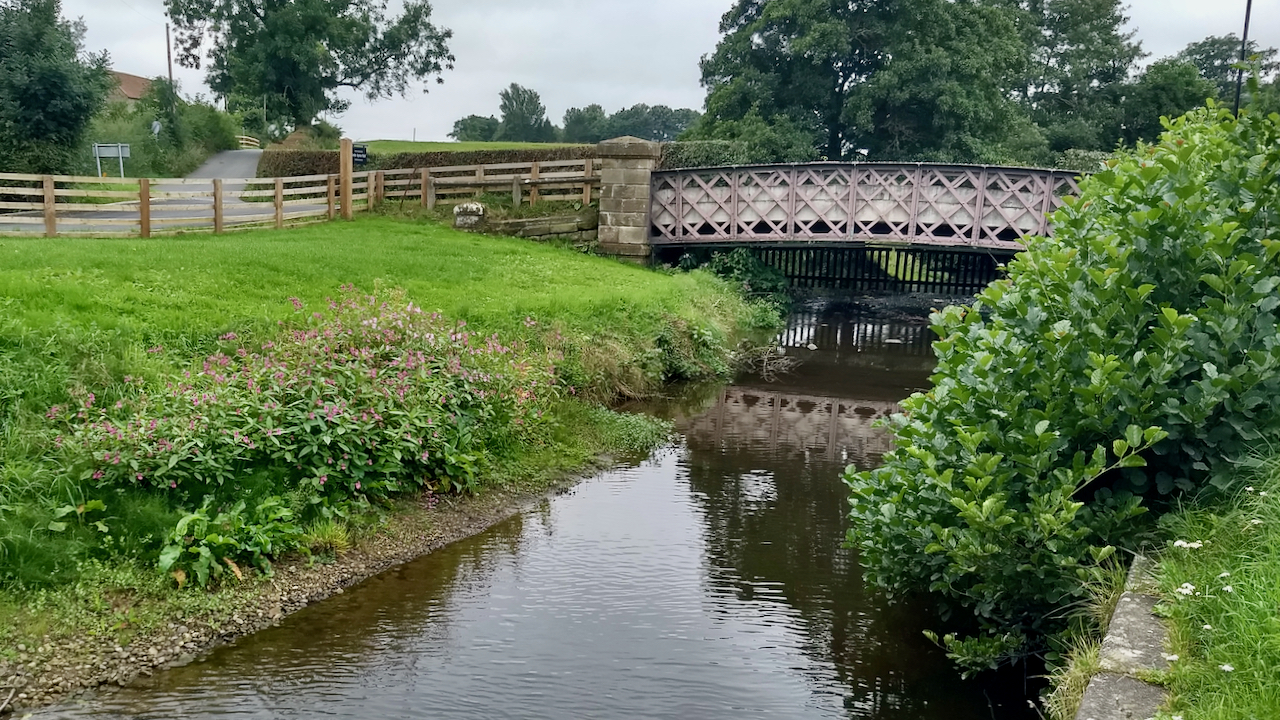The clump of pink flowers on the far bank is Himalayan balsam, a notorious invasive plant, the scourge of conservationists and environmentalists. The plant was particularly rampant on this stretch of the river about six years ago and they did have a blitz to eradicate it but it has returned. There are more clumps further downstream.
Himalayan balsam goes by a variety of names: Policeman’s Helmet, Gnome’s Hatstand and Kiss-me-on-the-mountain to name three. And, of course, its scientific name Impatiens glandulifera. It originates, as the name suggests, from the Himalayas, and was first introduced into Kew Gardens, and then adopted by Victorian plant collectors but quickly escaped from gardens1Pidd, H. (2021). Himalayan balsam: UK volunteers battle playboy of horticultural world. [online] the Guardian. Available at: https://www.theguardian.com/environment/2021/jun/07/himalayan-balsam-uk-volunteers-urged-to-help-to-battle-invasive-weed [Accessed 2 Sep. 2021]..
The problems with the plant are that its thick ground cover shades out other native plants, and in winter it dies back leaving river banks exposed to erosion, and exacerbating flooding downstream. Its flowers produce far more nectar than native flowers which means that bumblebees and other insects pollinators prefer the Himalayan Balsam at the expense of other wild flowers. And to cap it all Himalayan Balsam has a very aggressive method of seed dispersal. A single seed can produce a plant 2.5m high in a single season with each plant producing 800 seeds and each seed being capable of being projected 7m away.
The established way of control is by pulling it up before it seeds but there have been recent trials using the release of a rust fungus2Himalayan Balsam. (2014). Release update. [online] Available at: https://himalayanbalsam.cabi.org/release-update/ [Accessed 2 Sep. 2021].3The Tees Rivers Trust (2021). Busy bees as we are out with our student… – The Tees Rivers Trust. [online] Facebook.com. Available at: https://www.facebook.com/TheTeesRiversTrust/photos/a.362002673905801/3934886603284039/ [Accessed 2 Sep. 2021].. I am so wary of ‘biological controls’. The introduction of another alien species is dangerous.
The plant is not without its plaudits, a Mr. Fossey wrote in The Times in 2007: “at the end of the summer in our garden it continues to flower long after most other plants and extends the bumble bee season by at least two weeks. Sometimes it appears to be the only food available. And why have the conservationists turned against it? W. Keble Martin was happy to include it in his Concise British Flora, and, unlike some other “invaders”, it is easily controlled. It also composts well and, moreover, affords much childish fun in persuading the unwary to grasp the ripe seed pods and feel the resulting mini-explosions. If there isn’t a “Friends of the Himalayan Balsam”, then there ought to be.“4Legg, R. (2007) ‘Bee tempting’, Times, 26 Jul, 16, available: https://link-gale-com.ezproxy.is.ed.ac.uk/apps/doc/IF0503552937/GDCS?u=ed_itw&sid=bookmark-GDCS&xid=c2c8823b [accessed 02 Sep 2021].5Fossey, A. (2007) ‘Fun with balsam’, Times, 30 Jul, 16, available: https://link-gale-com.ezproxy.is.ed.ac.uk/apps/doc/IF0503505163/GDCS?u=ed_itw&sid=bookmark-GDCS&xid=b046bb9f [accessed 02 Sep 2021]. Let’s hope Mr Fossey has matured in his understanding.
And by the way, Mr. Fossey, the advice is not to compost it, just uproot it and leave to rot6Alien Invaders. (n.d.). [online] . Available at: https://static1.squarespace.com/static/5a941e5d4eddec67427063cc/t/5dca8a74c0e2e83d2a500812/1573554829456/Tees+Alien+Invaders_guide_online.pdf [Accessed 2 Sep. 2021]..
- 1Pidd, H. (2021). Himalayan balsam: UK volunteers battle playboy of horticultural world. [online] the Guardian. Available at: https://www.theguardian.com/environment/2021/jun/07/himalayan-balsam-uk-volunteers-urged-to-help-to-battle-invasive-weed [Accessed 2 Sep. 2021].
- 2Himalayan Balsam. (2014). Release update. [online] Available at: https://himalayanbalsam.cabi.org/release-update/ [Accessed 2 Sep. 2021].
- 3The Tees Rivers Trust (2021). Busy bees as we are out with our student… – The Tees Rivers Trust. [online] Facebook.com. Available at: https://www.facebook.com/TheTeesRiversTrust/photos/a.362002673905801/3934886603284039/ [Accessed 2 Sep. 2021].
- 4Legg, R. (2007) ‘Bee tempting’, Times, 26 Jul, 16, available: https://link-gale-com.ezproxy.is.ed.ac.uk/apps/doc/IF0503552937/GDCS?u=ed_itw&sid=bookmark-GDCS&xid=c2c8823b [accessed 02 Sep 2021].
- 5Fossey, A. (2007) ‘Fun with balsam’, Times, 30 Jul, 16, available: https://link-gale-com.ezproxy.is.ed.ac.uk/apps/doc/IF0503505163/GDCS?u=ed_itw&sid=bookmark-GDCS&xid=b046bb9f [accessed 02 Sep 2021].
- 6Alien Invaders. (n.d.). [online] . Available at: https://static1.squarespace.com/static/5a941e5d4eddec67427063cc/t/5dca8a74c0e2e83d2a500812/1573554829456/Tees+Alien+Invaders_guide_online.pdf [Accessed 2 Sep. 2021].

Leave a Reply